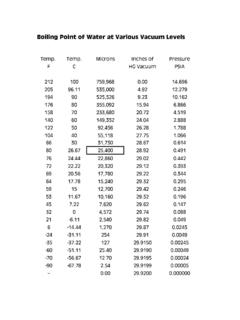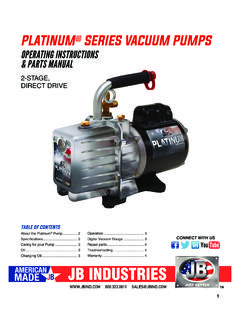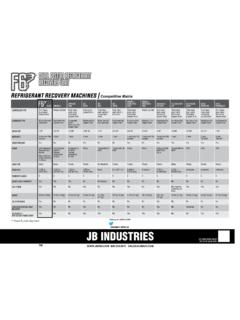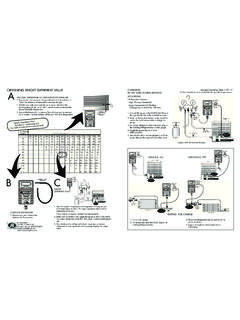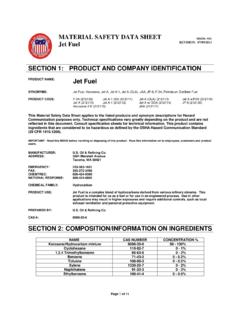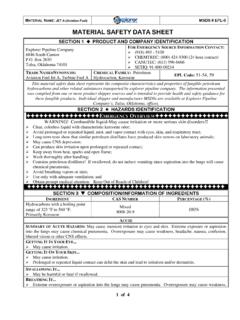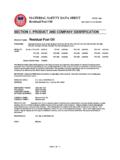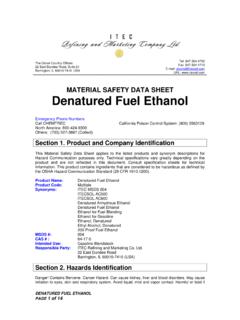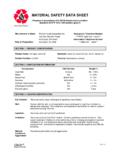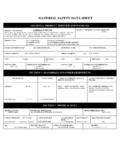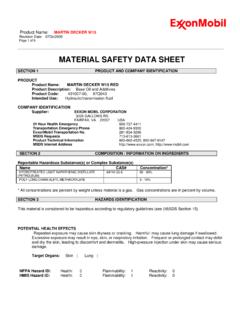Transcription of MATERIAL SAFETY DATA SHEET - JB Industries
1 October 1, 2012 Date Revised : Page 1 of 4 MATERIAL SAFETY data SHEET 1. PRODUCT AND COMPANY IDENTIFICATION Brand Name: Black Gold Product Name(s): Vacuum Pump Oil Manufacturer: Pinnacle Oil, Inc. Address: 5009 W. 81st Street State: IN Phone: (800) 829-8899 Emergency Number: (800) 829-8899 City: Indianapolis Zip: 46268 Fax: (317) 875-0889 2. COMPOSITION/INFORMATION ON INGREDIENTS Component Name: CAS#: % Volume: ACGIH TLV ACGIH STEL OSHA PEL Oil Mist, If Generated None N/A 5 mg/m3, 8 hr. TWA 10 mg/m3, 8 hr. TWA 5 mg/m3, 8 hr. TWA Lubricant Base Oil(Petroleum) Mixture 100 See Oil Mist, if Generated See Oil Mist, if Generated See Oil Mist, if Generated The base oil for this product can be a mixture of any of the following highly refined petroleum streams: 64741-88-4,64742-01-4,64742-54-7,64742-6 5-0,64742-47-8,8042-47-5,64742-46-7,6474 2-52-5,64742-54-7,72623-84-8,72623-85-9, 72623-86- 0,72623-87-1,178603-63-9,178603-64-0,178 603-65-1,178603-66-2, 68037-01-4, 151006-63-2 Note: State, local, or other agencies or advisory groups may have established more stringent limits.
2 Consult an industrial hygienist or similar professional, or your local agencies, for further information. All components are listed on the TSCA inventory. 3. HAZARDS IDENTIFICATION P otentia l Hea lth E ffec ts Emergency Overview: Oily Liquid with Hydrocarbon Odor. Can cause eye irritation. Can burn in fire, releasing toxic vapors, gases and fumes. Extremely slippery when spilled. Eye: Contact may cause mild eye irritation including stinging, watering, and redness. Skin: Contact may cause mild skin irritation including redness, and a burning sensation. Prolonged or repeated contact can worsen irritation by causing drying and cracking of the skin leading to dermatitis(inflammation). No harmful effects from skin absorption are expected.
3 Ingestion: No harmful effects expected from ingestion. Inhalation: No information available. Studies by other exposure routes suggest a low degree of toxicity by inhalation. Chronic Effects: Effects of overexposure may include irritation of the nose and throat, irritation of the digestive tract, nausea and diarrhea. Potential Environmental Effects: See Ecological Information, See Section 12. 4. FIRST AID MEASURES Eye: If irritation or redness develops, move victim away from exposure and into fresh air. Flush eyes with clean water. If symptoms persist, seek medical attention. Skin: Wipe MATERIAL from skin and remove contaminated shoes and clothing. Cleanse affected area(s) thoroughly by washing with mild soap and water and, if necessary, a waterless skin cleanser.
4 If irritation or redness develops and persists, seek medical attention. Inhalation: If respiratory symptoms develop, move victim away from source of exposure and into fresh air. If symptoms persist, seek medical attention. If victim is not breathing, clear airway and immediately begin artifical respiration. If breathing difficulties develop, oxygen should be administered by qualified personnel. Seek immediate medical attention. Ingestion: First aid is not normally required; however, if swallowed and symptoms develop, seek medical attention. Note to Physicans: High pressure hydrocarbon injection injuries may produce a substantial necrosis of underlying tissue despite an innocuous appearing external wound.
5 Often these injuries require extensive emergency surgical debridement and all injuries should be evaluated by a specialist in order to assess the extent of the injury. Acute aspirations of large amounts of oil-laden MATERIAL may product a serious aspiration pneumonia. Patients who aspirate these oils should be October 1, 2012 Date Revised : Page 2 of 4 followed for the development of long-term sequelae. Inhalation exposure to oil mists below current workplace exposure limits is unlikely o cause pulmonary abnormalities. 5. FIRE FIGHTING MEASURES Flash Point: 390F-D92 LEL/UEL % No data Auto Igniton Temperature: No data OSHA Flammability Class: Not applicable Extinguishing Media: Dry chemical, carbon dioxide, foam, or water spray is recommended.
6 Water or foam may cause frothing of materials heated above 212F. Carbon dioxide can displace oxygen. Use caution when applying carbon dioxide in confined spaces. Fire Fighting Instructions: For fires beyond the incipient stage, emergency responders in the immediate hazard area should wear bunker gear. When the potential chemical hazard in unknow, in enclosed or confined spaces, or when explicitly required by DOT, a self contained breathing apparatus should be worn. In addition, wear other appropriate protective equipment as conditions warrant(see Section 8). Isolate immediate hazard area, keep unauthorized personnel out. Stop spill release if it can be done with minimal risk. Move undamaged containers from immediate hazard area if it can done with minimal risk.
7 Water spray may be useful in minimizing or dispersing vapors and to protect personnel. Cool equipment exposed to fire with water, if it can be done with minimal risk. Avoid spreading burning liquid with water used for cooling purposes. Fire and Explosion Hazards: This MATERIAL may burn, but will not ignite readily. Vapors are heavier than air and can accumulate in low areas. If container is not properly cooled, it can rupture in the heat of a fire. 6. ACCIDENTIAL RELEASE MEASURES Accidental Release Measures: This MATERIAL may burn, but will not ignite readily. Keep all sources of ignition away from spill/release. Stay upwind and away from spill/release. Notify persons down wind of the spill/release, isolate immediate hazard area and keep unauthorized personnel out.
8 Stop spill/release if it can be done with minimal rish. Wear appropriate protective equipment including respiratory protection as conditions warrant(see Section 8). Prevent spilled MATERIAL from entering sewers, storm drains, other unauthorized drainage systems, and natural waterways. Dike far ahead of spill for later recovery or disposal. Spilled MATERIAL may be absorbed into an appropriate absorbent MATERIAL . Notify fire authorities and appropriate federal, state and local agencies. Immediate cleanup of any spill is recommended. If spill of any amount is made into or upon navigable waters, the contiguous zone, or adjoining shorelines, notify the National Response Center(phone number 800-424-8802).
9 7. HANDLING AND STORAGE Handling: Do not enter confined spaces such as tanks or pits without following proper entry procedures such as ASTM D-4276 and 29 CFR The use of appropriate respiratory protection is advised when concentrations exceed any established exposure limits(See Section 2 and 8). Do not wear contaminated clothing or shoes. Use good personal hygiene practices. High pressure injection of hydrocarbon fuels, hydraulic oils or greases under the skin may have serious consequences even though no symtoms or injury may be apparent. This can happen accidentally when using high pressure equipment such as high pressure grease guns, fuel injectiton appartus or from pinhole leaks in tubing of high pressure hydraulic oil equipment.
10 Empty containers retain residue and may be dangerous. Do not pressurize, cut, weld, braze, solder, drill, grind, or expose such containers to heat, flame, sparks, or other sources of ignition. They may explode and cause injury or death. Empty drums should be completely drained, properly bunged, and promptly shipped to the supplier or drum reconditioner. All containers should be disposed of in an environmentally safe manner and in accordance with governmental regulations. Before working on or in tanks which contain or have contained this MATERIAL , refer to OSHA regulations, ANSI and other references pertaining to cleaning, repairing, welding, or other contemplated operations. Storage: Keep container(s) tightly closed.

